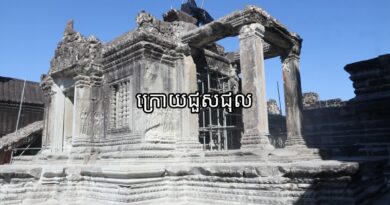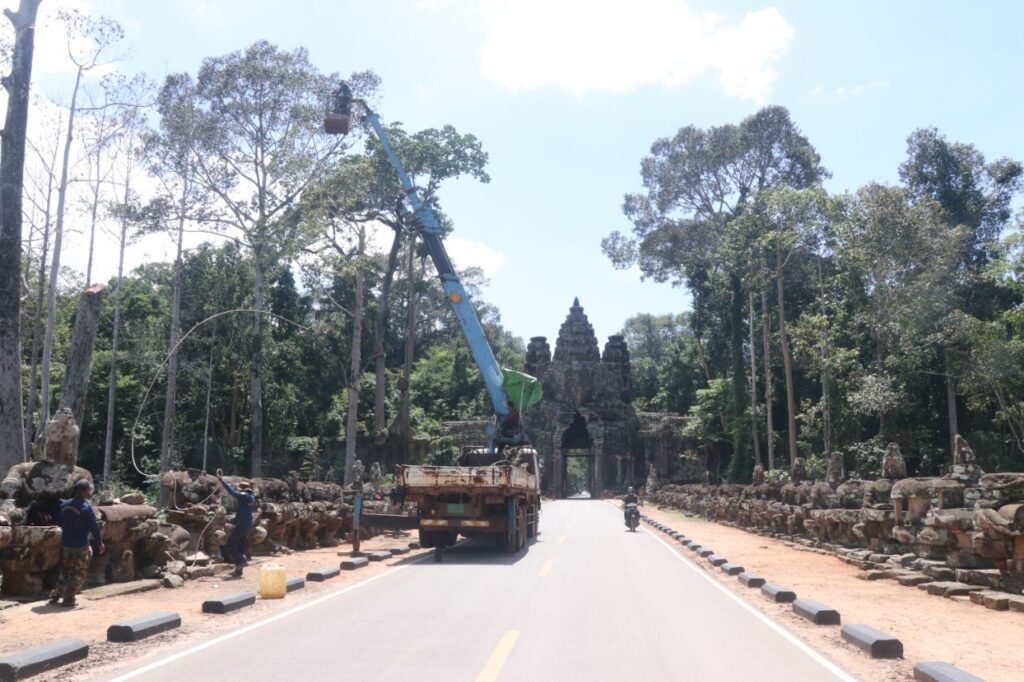ក្រុមការងារគ្រប់គ្រងហានិភ័យដើមឈើនៃនាយកដ្ឋានគ្រប់គ្រងទឹក ព្រៃឈើ និងហេដ្ឋារចនាសម្ព័ន្ធ កំពុងចុះកាត់ក្រី ដើមឈើហានិភ័យធំៗនៅរមណីយដ្ឋានអង្គរ ខណៈដែលរដូវវស្សាការងារនេះ មានភាពមមាញឹកខុសពីរាល់ដង។
លោក ទៀន សុធី បុគ្គលិកបច្ចេកទេសនៃនាយកដ្ឋានគ្រប់គ្រងទឹក ព្រៃឈើ និងហេដ្ឋារចនាសម្ព័ន្ធ បានឱ្យដឹងថា ក្រុមការងាររបស់លោកបានប្រើប្រាស់ឡានស្ទួចដងវែង ដើម្បីកាត់ក្រី និងដកដើមឈើ ហានិភ័យនៅខ្លោងទ្វារជ័យ ដែលបានដុះគ្របបង្កាន់ដៃនាគ និងអាចមានហានិភ័យជាយថាហេតុ។
លោក សុធី បញ្ជាក់ថា ការកាត់ និងដកដើមឈើមានបីរបៀបដែលបាននិងកំពុងអនុវត្តន៍ ក្នុងនោះរួមមាន ប្រើឡានស្ទួច ដំឡើងរន្ទា និងឡើងដោយកម្លាំងមនុស្ស។ លោកពន្យល់ថា ការប្រើឡានស្ទួច មានភាពរហ័ស និងលឿន តែអាចប្រើប្រាស់បាននៅលើដងផ្លូវស្រឡះៗប៉ុណ្ណោះ។ ចំណែកនៅក្នុងប្រាសាទ ច្រើនប្រើរន្ទា និងមនុស្សឡើងដូចជាករណីបាក់មែក ឬទ្រេតគ្របលើតួប្រាសាទ ជាដើម។ល។
ដ្បិតថា មានភាពងាយស្រួលក៏ពិតមែន តែការប្រើមធ្យោបាយឡានស្ទួចនេះ ក៏ត្រូវការកម្លាំងច្រើននាក់ មិនខុសពីមធ្យោបាយផ្សេងទៀតដែរ ពិសេសអ្នកឡើងចងខ្សែ ត្រូវការអ្នកមានជំនាញស្ទាត់ ដឹងពីរបៀបចង ក្នុងនោះកម្លាំងច្រើននាក់ចាំទាញខ្សែនៅផ្នែកខាងក្រោម។ លោក សុធី បន្ថែមថា មែកឈើខ្លះត្រូវការចងខ្សែតែមួយទេ តែមែកខ្លះរៀងធំត្រូវការចងខ្សែដល់៤ក៏មានដែរ ដើម្បីធានាពីហានិភ័យមនុស្ស និងប្រាសាទ។ យ៉ាងណារបៀបនេះ អាចកាត់ដើមឈើដែលមានកម្ពស់ ៣០ម៉ែត្រចុះប៉ុណ្ណោះ លើសពីនោះគេត្រូវដំឡើងរន្ទាដើម្បីឡើងកាត់ដដែល ដូចជាដើមឈើខ្លះនៅ ប្រាសាទបាយ័នដែលមានកម្ពស់រហូតដល់ជាង៥០ម៉ែត្រ។
ចំពោះបច្ចេកទេសដំឡើងរន្ទាវិញ ភាគច្រើនធ្វើនៅក្នុងប្រាសាទ ដូចករណីដើមស្ពង់នៅប្រាសាទបាយ័ន។ ការប្រើរន្ទានេះត្រូវចំណាយពេលយូរទាំងការដំឡើង និងការរើវិញ គឺអាចប្រើពេលខ្ទង់ខែដើម្បីកាត់ក្រី ដើមឈើមួយៗបាន៕
អត្ថបទ៖ នាង សំណាង
រូបភាព៖ យី សុថា, ភោគ ជា
Understanding about tree pruning at the Angkor site
The tree risk management team of the Department of Water, Forestry, and Infrastructure Management is busily pruning large risk trees at the Angkor site in the rainy season.
Mr. Tien Sothy, Technical Officer of the Department of Water, Forestry, and Infrastructure Management, said that his team used long cranes to prune and remove the risk trees at the Angkor Thom’s Victory Gate, which had grown to cover the Naga balustrades and could be at risk.
Mr. Sothy stated that there are three ways to cut and remove trees that have been practiced, including using cranes, scaffolding, and man-made climbing. He explains that using a crane is quick and easy, but can only be used on clear roads. In temples, scaffolding and people are often used, such as in the case of broken branches or tilting over the temple, etc.
Although it is easy, the use of this crane also requires a lot of strength, not unlike other means, especially those who tie the rope need a skilled person who knows how to tie in that many men waiting to pull the rope. Mr. Sothy added that some branches need to be tied with a single rope, but some large branches need to be tied with up to four ropes to ensure the safety of the working team and temples. However, this method can cut down trees that are only 30 meters high, in addition, they have to install scaffolding to climb, like some trees in Bayon temple that are up to 50 meters high.
As for the scaffolding installation technique, most of it is done in the temple, as in the case of the Spong tree at Bayon temple. Using this scaffolding takes a long time, both installation and relocation can take months to prune individual trees.
Article: Neang Samnang
Photos: Yi Sotha, Phouk Chea
Share:
Our Latest News

អ្នកជំនាញអាជ្ញាធរជាតិអប្សរា បានបញ្ចប់ការជួសជុលបណ្ណាល័យខាងត្បូងនៅរួតទី២របស់ប្រាសាទអង្គរវត្ត -APSARA National Authority to complete the restoration of Southern Library in Angkor Wat Temple’s Second Terrace- 03 January 2025
រចនាសម្ពន្ធនៃបណ្ណាល័យខាងត្បូង នៅរួតទី២របស់ប្រាសាទអង្គរវត្ត មានអាយុកាលជិត១ពាន់ឆ្នាំ ដែលរងការខូចខាត បានរឹងមាំឡើងវិញហើយ បន្ទាប់ពីក្រុមអ្នកជំនាញនៃអាជ្ញាធរជាតិអប្សរាជួសជុលអស់រយៈពេល៥ខែមក។




